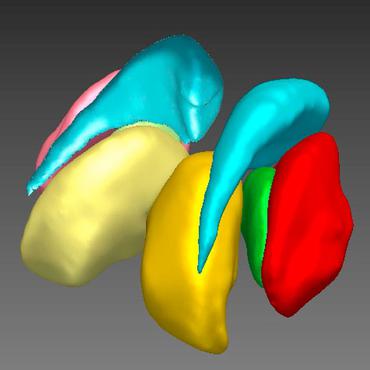Search Results for author: Dafna Ben Bashat
Found 8 papers, 0 papers with code
Noise propagation and MP-PCA image denoising for high-resolution quantitative T2* and magnetic susceptibility mapping (QSM)
no code implementations • 30 Apr 2024 • Liad Doniza, Mitchel Lee, Tamar Blumenfeld Katzir, Moran Artzi, Dafna Ben Bashat, Dvir Radunsky, Karin Shmueli, Noam Ben-Eliezer
Quantitative Susceptibility Mapping (QSM) is a technique for measuring magnetic susceptibility of tissues, aiding in the detection of pathologies like traumatic brain injury and multiple sclerosis by analyzing variations in substances such as iron and calcium.
Contour Dice loss for structures with Fuzzy and Complex Boundaries in Fetal MRI
no code implementations • 25 Sep 2022 • Bella Specktor Fadida, Bossmat Yehuda, Daphna Link Sourani, Liat Ben Sira, Dafna Ben Bashat, Leo Joskowicz
In this paper, we study the use of the Contour Dice loss for both problems and compare it to other boundary losses and to the combined Dice and Cross-Entropy loss.
Partial annotations for the segmentation of large structures with low annotation cost
no code implementations • 25 Sep 2022 • Bella Specktor Fadida, Daphna Link Sourani, Liat Ben Sira Elka Miller, Dafna Ben Bashat, Leo Joskowicz
We tested the method with the popular soft Dice loss for the fetal body segmentation task in two MRI sequences, TRUFI and FIESTA, and compared full annotation regime to partial annotations with a similar annotation effort.
Automatic fetal fat quantification from MRI
no code implementations • 8 Sep 2022 • Netanell Avisdris, Aviad Rabinowich, Daniel Fridkin, Ayala Zilberman, Sapir Lazar, Jacky Herzlich, Zeev Hananis, Daphna Link-Sourani, Liat Ben-Sira, Liran Hiersch, Dafna Ben Bashat, Leo Joskowicz
It consists of two steps: 1) model-based semi-automatic fetal fat segmentations, reviewed and corrected by a radiologist; 2) automatic fetal fat segmentation using DL networks trained on the resulting annotated dataset.
BiometryNet: Landmark-based Fetal Biometry Estimation from Standard Ultrasound Planes
no code implementations • 29 Jun 2022 • Netanell Avisdris, Leo Joskowicz, Brian Dromey, Anna L. David, Donald M. Peebles, Danail Stoyanov, Dafna Ben Bashat, Sophia Bano
Comparison and cross-validation of three different biometric measurements on two independent datasets shows that BiometryNet is robust and yields accurate measurements whose errors are lower than the clinically permissible errors, outperforming other existing automated biometry estimation methods.
Fetal Brain Tissue Annotation and Segmentation Challenge Results
no code implementations • 20 Apr 2022 • Kelly Payette, Hongwei Li, Priscille de Dumast, Roxane Licandro, Hui Ji, Md Mahfuzur Rahman Siddiquee, Daguang Xu, Andriy Myronenko, Hao liu, Yuchen Pei, Lisheng Wang, Ying Peng, Juanying Xie, Huiquan Zhang, Guiming Dong, Hao Fu, Guotai Wang, ZunHyan Rieu, Donghyeon Kim, Hyun Gi Kim, Davood Karimi, Ali Gholipour, Helena R. Torres, Bruno Oliveira, João L. Vilaça, Yang Lin, Netanell Avisdris, Ori Ben-Zvi, Dafna Ben Bashat, Lucas Fidon, Michael Aertsen, Tom Vercauteren, Daniel Sobotka, Georg Langs, Mireia Alenyà, Maria Inmaculada Villanueva, Oscar Camara, Bella Specktor Fadida, Leo Joskowicz, Liao Weibin, Lv Yi, Li Xuesong, Moona Mazher, Abdul Qayyum, Domenec Puig, Hamza Kebiri, Zelin Zhang, Xinyi Xu, Dan Wu, Kuanlun Liao, Yixuan Wu, Jintai Chen, Yunzhi Xu, Li Zhao, Lana Vasung, Bjoern Menze, Meritxell Bach Cuadra, Andras Jakab
Automatic segmentation of the developing fetal brain is a vital step in the quantitative analysis of prenatal neurodevelopment both in the research and clinical context.
Automatic linear measurements of the fetal brain on MRI with deep neural networks
no code implementations • 15 Jun 2021 • Netanell Avisdris, Bossmat Yehuda, Ori Ben-Zvi, Daphna Link-Sourani, Liat Ben-Sira, Elka Miller, Elena Zharkov, Dafna Ben Bashat, Leo Joskowicz
Fetal MRI is increasingly used for fetal brain assessment.
Compressed sensing for longitudinal MRI: An adaptive-weighted approach
no code implementations • 10 Jul 2014 • Lior Weizman, Yonina C. Eldar, Dafna Ben Bashat
Methods: The proposed approach utilizes the possible similarity of the repeated scans in longitudinal MRI studies.


